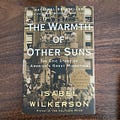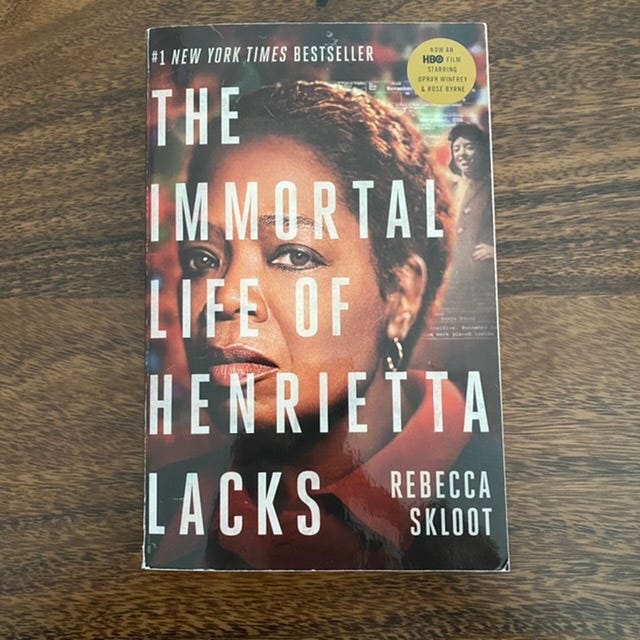Happy Friday, readers!
Though your reading of Black history shouldn’t be contained to the month of February, it’s a great time to intentionally delve even deeper into the Black voices that generally haven’t been part of American history or literature.
To cap off the first week of the month, I finished Isabel Wilkerson’s utterly magnificent The Warmth of Other Suns, and though I’m not all the way done yet, I’ve been enjoying the audio edition of Rebecca Skloot’s The Immortal Life of Henrietta Lacks on my walks around the neighborhood.
These books were both published in 2010 and now, just over 10 years later, are both regularly found in Best Black History lists. It’s especially meaningful because women historians and journalists aren’t as widely published or marketed as their male counterparts. These books show that history (and science) written by women can be just as compelling and impactful.
Let’s get to it. As always, I’d love to hear what you’re reading and enjoying this week!
Quick interlude — In the last month or so, I’ve sent a series of short bookish essays to my paid subscribers:
Paid subscribers get an extra email from me each week, alternating between essays and a link round-up that I call These Are a Few of My Favorite Links. No pressure whatsoever, but I’d be honored by your support of Read More Books:
The Warmth of Other Suns by Isabel Wilkerson
Published: 2010 | Pages: 543
Ever since Wilkerson’s book was published back in 2010, it’s been praised as one of the great histories of all-time regarding Black America.
And yet it covers a period of American history that most people have never heard of: the Great Migration, which took place between 1915 and 1970. In these 5+ decades, millions of Black men, women, and children moved from southern Jim Crow states to northern and western “free” states (all the states were technically “free,” but in the south it was basically in name only).
Wilkerson didn’t write the story of this migration in the way you’d expect though. She picked three people who moved north/west in three different decades—telling each of their stories from basically birth to death, and how the migration impacted their lives. Ida went from Mississippi to Chicago, George went from Florida to New York City, and Robert went from Louisiana to Los Angeles.
Interspersed between those incredibly personal narratives are the big stories of the era: the terrifying era of lynching, a number of race riots (most of which I’d never heard of), the rash of bombings that plagued Black homes in the early decades of the 20th century, the Civil Rights struggle and MLK’s assassination.
Atop the great stories (which were obviously uncovered through hours and hours of interviewing), Wilkerson writes with an uncommonly readable elegance. She weaves everything together over the course of about 500 pages in such a way that I felt like I got a real grasp of the entire era, and it was never a chore to read. It’s a large book, but I was excited to pick it up every morning and ended up bingeing the final couple hundred pages this week.
The Warmth of Other Suns is as easy a 5-star rating as I’ve given. With some books I’ll hem and haw between 4 and 5, but I knew right as I closed this one that it was worth 5 stars, and that it would likely make my Best Reads of ‘22 list at the end of the year. I have a feeling that Ida, George, and Robert are going to stay with me for a long time.
Wilkerson’s book is exceptional on all fronts. The short sections and chapters make it digestible for readers of all types and tastes. I just can’t heap enough praise onto The Warmth of Other Suns, so go get it ASAP!
The Immortal Life of Henrietta Lacks by Rebecca Skloot
Published: 2010 | Pages: 381
From a young age, science writer and author Rebecca Skloot was interested in the story of the famous, immortal HeLa cells. For any scientist whose work involves cell culture, HeLa is a familiar name. For those of us outside that world, it’s likely not.
Most human cells die at some point—seems logical, yeah? But in 1951, scientists at Johns Hopkins discovered that the cancer cells of a young Black woman refused to die. They kept replicating and replicating and replicating . . . and are still doing so today. It’s pretty mind-blowing, really. This is one of those stories where the facts alone make for a great narrative.
That young Black woman, Henrietta Lacks, lent her name to those cells, despite not living to see their impact.
Skloot goes well beyond just Henrietta’s story, though (which was being widely told for the first time with this book), and gets into the exploitation of human subjects in medical testing, who, more often than not, have been Black or poor or both.
The Lacks family had no idea that Henrietta’s cells were ever used in scientific research and for-profit ventures alike, let alone that HeLa cells led to most of the important cellular science breakthroughs of the last 70 years.
I’m not sold on Skloot’s insertion of herself into the narrative, but I get why she went that route. It was somewhat necessary in order to tell the story of Deborah Lacks (Henrietta’s daughter)—it just seems a touch self-serving as I approach the end of the book.
Overall, though, The Immortal Life of Henrietta Lacks is an incredibly well-told story that anyone can read—no scientific background necessary. For those who happen to be in any sort of scientific field, it should be required reading (which I’m pretty sure it is for hundreds of college programs around the world).
That’s all for me this week. Thanks so much for the time and inbox space; I’m deeply grateful.
Until next Friday,
-Jeremy





I’ve read and loved both of these books. Great recommendation!
Thanks for more great book recs Jeremy . This wk I finished listening to TheLibraryBook. It tells the story of America’s largest library fire. Interspersed with the Hx of that library and the evolution of what the library means to many communities today. Anyone who loves books and Libraries as many of us do should check it out (4/5stars)